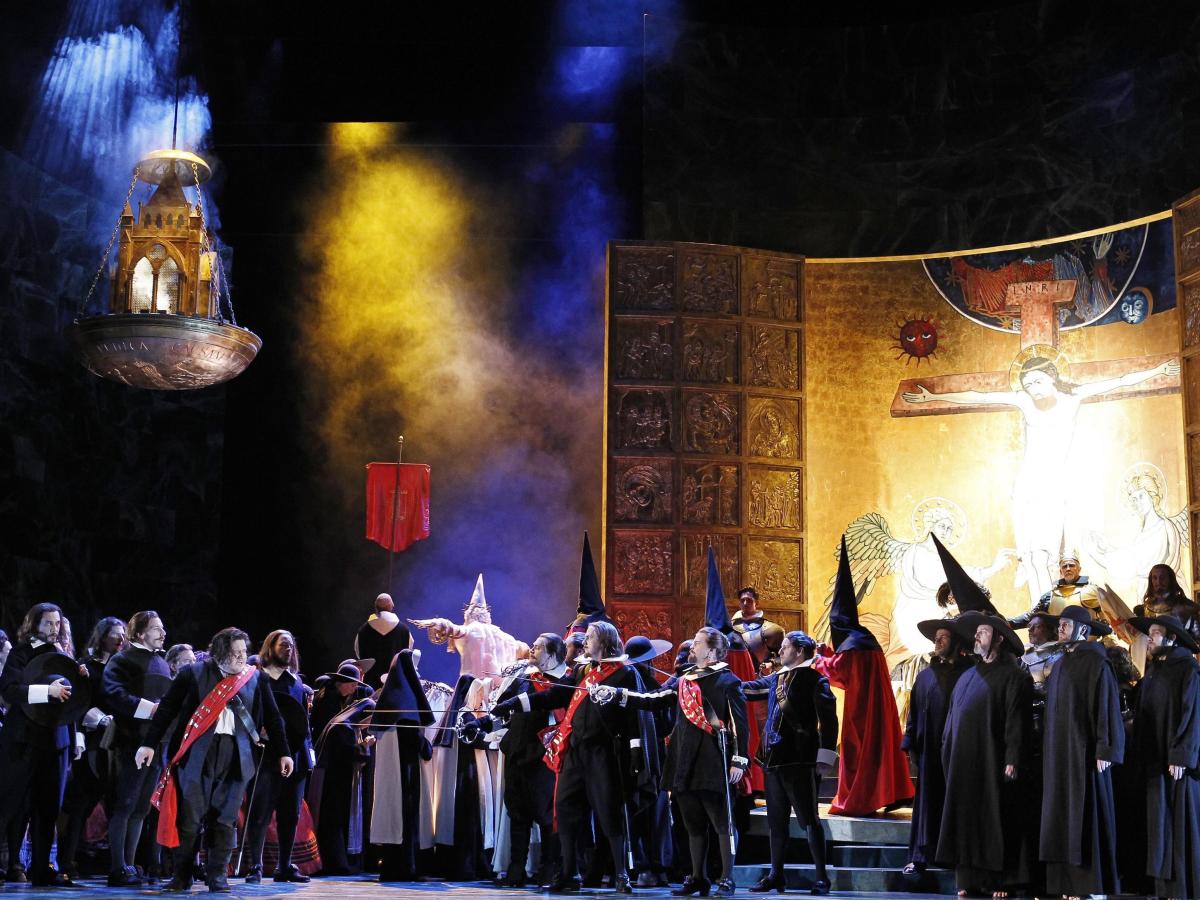The massive auto-da-fé scene from Don Carlos, Image via Opera Australia by Jeff Busby
Reviewing is not a paint-by-numbers activity but the sheer scale of Don Carlos cannot go unremarked. A cast of more than 200 and a huge orchestra heavy on booming horns and bass woodwinds ensure this is an opera of extraordinary impact
The voices in this production have appropriate size and power too. Diego Torre as the eponymous tenor has a magnificent richness to his voice which is simply delicious. It is a pity he does not look the part of a romantic hero; the only jarring note in a production that is otherwise a visual as well as an auditory feast.
The opera opens outside the tomb of Charles V and our first glimpse is of a shadow which only gradually moves into the figure of a monk evoking the ghost of the dead king. It is an electrifying beginning and every scene that follows has the same attention to detail.
Set and costume designer Paul Brown pays homage to the work of Velasquez – in one case quite literally when a portrait of the queen mimics the master’s Las Meninas. Dark marble, huge pannier skirts and a courtyard worthy of Córdoba place us clearly in the Spain of Phillip II – and the Flemmish petitioners appear to have walked directly out of a Rembrandt.
The massive auto-da-fé scene with its parade of heretics, rebellious peasants and enormous smoking incense burner is one of those impactful moments that will be remembered years from now.
Don Carlos is based on a historical fact: Elisabeth of Valois, daughter of Henry II of France, was betrothed to the young Carlos but married to his father Phillip II of Spain as a part of the treaty which ended the French Wars of Religion.
Verdi – who originally wrote a French version then revised it to produce this Italian form – imagined the rest: the devastated young couple, the son’s rebellion against the father, Carlos’s support of the Flemmish and the sub-plots of other lovers and friends and placed it against the dramatic backdrop of the Spanish Inquisition.
Elijah Moshinsky’s intricate and layered production is psychological and sumptuous and always polished.
Don Carlos – in this shorter Italian version – is three hours and forty-five minutes long, including a 30 minute interval. It is a long time and this reviewer was not the only person queuing to go in on opening night wondering if she would make it back after the interval. But I didn’t see anybody leave and nor did I feel that I had spent a long night in my seat.
The magnificently choreographed crowd scenes were a back-drop to a fine cast. The bass voices of Giacomo Prestia as Phillip II and Daniel Sumegi as the Grand Inquisitor were powerful and resonant, an excellent match for Torre’s romantic tenor. Victoria Yastrebova as Elisabeth was cut glass in voice and restrained dutifulness; Milijana Nikolic as Princess Eboli, was rich and seductive.
Of the three operas in the current season, Don Carlos is the least often performed but this is due to no weakness in the work, more to the cost of staging it. But for audiences choosing between Madama Butterfly, Don Giovanni and Don Carlos in the current season, Don Carlos is the standout: a magnificent production that leaves audiences musically and dramatically sated.
Don Carlos
Opera Australia
Arts Centre Melbourne, State Theatre
May 20 – 29, 2015
Tickets





